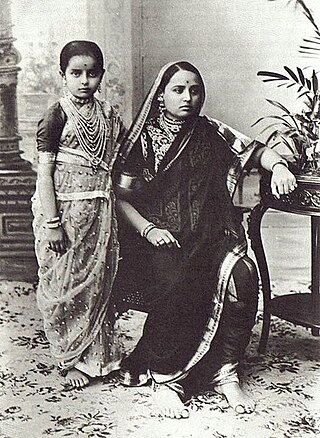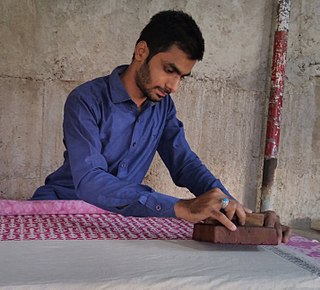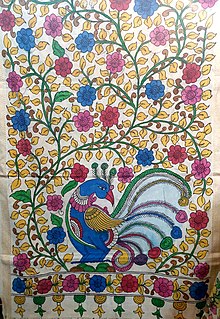
A sari is a women's garment from the Indian subcontinent, that consists of an un-stitched stretch of woven fabric arranged over the body as a robe, with one end attached to the waist, while the other end rests over one shoulder as a stole (shawl), sometimes baring a part of the midriff. It may vary from 4.1 to 8.2 metres in length, and 60 to 120 centimetres in breadth, and is form of ethnic wear in Bangladesh, India, Pakistan, Sri Lanka, and Nepal. There are various names and styles of sari manufacture and draping, the most common being the Nivi style. The sari is worn with a fitted bodice also called a choli and a petticoat called ghagra, parkar, or ul-pavadai. It remains fashionable in the Indian Subcontinent today.

Krishna district is a district in the coastal Andhra Region in Indian state of Andhra Pradesh, with Machilipatnam as its administrative headquarters. It is surrounded on the East by Bay of Bengal, West by Guntur, Bapatla and North by Eluru and NTR districts and South again by Bay of Bengal. In 2022 Krishna district was divided into Krishna and NTR districts.
Ikat is a dyeing technique from Indonesia used to pattern textiles that employs resist dyeing on the yarns prior to dyeing and weaving the fabric. The term is also used to refer to related and unrelated traditions in other cultures. In Southeast Asia, where it is the most widespread, ikat weaving traditions can be divided into two general clades. The first is found among Daic-speaking peoples. The second, larger group is found among the Austronesian peoples and spread via the Austronesian expansion. Similar dyeing and weaving techniques that developed independently are also present in other regions of the world, including India, Central Asia, Japan, Africa, and the Americas.

Machilipatnam, also known as Masulipatnam and Bandar, is a city in Krishna district of the Indian state of Andhra Pradesh. It is a municipal corporation and the administrative headquarters of Krishna district. It is also the mandal headquarters of Machilipatnam mandal in Machilipatnam revenue division of the district. The ancient port town served as the settlement of European traders from the 16th century, and it was a major trading port for the Portuguese, British, Dutch and French in the 17th century.

Chintz is a woodblock printed, painted, stained or glazed calico textile that originated in Golconda in the 16th century. The cloth is printed with designs featuring flowers and other patterns in different colours, typically on a light, plain background.

A palampore or (Palempore) is a type of hand-painted and mordant-dyed bed cover that was made in India for the export market during the eighteenth century and very early nineteenth century. Only the wealthiest classes could afford to buy palampore; therefore, the few examples that have survived are often quite valuable today. Palampore were primarily exported to Europe and to Dutch colonists in Indonesia and what was then called Ceylon.

The culture of Andhra Pradesh embodies some very exclusive and special entities.

A Sambalpuri sari is a traditional handwoven bandha (ikat) sari wherein the warp and the weft are tie-dyed before weaving. It is produced in the Sambalpur, Balangir, Bargarh, Boudh and Sonepur districts of Odisha, India. The sari is a traditional female garment in the Indian subcontinent consisting of a strip of unstitched cloth ranging from four to nine meters in length that is draped over the body in various styles.

The crafts of India are diverse, rich in history, culture and religion. The craft of each state in India reflect the influence of different empires. Throughout centuries, crafts have been embedded as a culture and tradition within rural communities.

Pedana Kalamkari also known as Machilipatnam style of Kalamkari work which involves vegetable dyed block-painting of a fabric. it is produced at Pedana a nearby town of Machilipatnam in Krishna district of the Indian state of Andhra Pradesh. It was registered as one of the geographical indication from Andhra Pradesh under handicraft goods by Geographical Indications of Goods Act, 1999.
Kappaladoddi is a village in Krishna district of the Indian state of Andhra Pradesh. It is located in Guduru mandal. It is renowned for its Kalamkari works and the traditional Handloom arts.

Bagh print is a traditional Indian handicraft originating in Bagh, Dhar district of Madhya Pradesh, India. The process is characterised by hand printed wood block relief prints with naturally sourced pigments and dyes. Bagh print motifs are typically geometric, paisley, or floral compositions design, dyed with vegetable colours of red and black over a white background, and is a popular textile printing product. Its name is derived from the village Bagh located on the banks of the Bagh River.
Mangalagiri Sarees and Fabrics are produced by performing handicraft weaving in Mangalagiri, a town in Guntur district of the Indian state of Andhra Pradesh. It was registered as one of the handicraft in the geographical indication from Andhra Pradesh by Geographical Indications of Goods Act, 1999.

Srikalahasti Kalamkari is a style of Kalamkari work which involves dyed hand-painting of a fabric. It is produced in Srikalahasti of Tirupati district in the Indian state of Andhra Pradesh. It was registered as one of the geographical indication from Andhra Pradesh, under handicraft goods by Geographical Indications of Goods Act, 1999. GI Application for Srikalahasti Kalamkari was filed by Kalamkari Artisans Revival and Upsurge for National Acclaim (KARUNA).
Jonnalagadda Gurappa Chetty is an Indian painter, craftsman and writer, known for his contributions for the revival of the Indian textile art form of Kalamkari. He is a recipient of honours such as Shilpaguru, Rasthriya Samman, Tulsi Samman and Kamaladevi Vishwa Karigar Award. The Government of India awarded him the fourth highest civilian honour of the Padma Shri, in 2008, for his contributions to Kalamkari art.
The Surat Zari / Jari Craft is a textile product of Surat district in Gujarat, India, which is made from yarns of silk and cotton mixed with gold, silver or copper. The zari threads are used to make intricate designs by weaving into generally silk fabrics. Its use is extensive in textile industries and handicrafts. The Surat Zari is either woven on cloth or hand embroidered to form fabric borders or used as part on the body of the cloth. The zaris are used in fabrics made in Varanasi and a few other places in Uttar Pradesh, Tamil Nadu, Karnataka and Andhra Pradesh. Banarasi saris made in Varanasi and Kanjivaram Saris of South India use Surat Zari extensively.

Abdul Kadar Khatri (1961–2019) was an Indian master craftsman of traditional hand block printing known as Bagh Print. He was the son of Ismail Sulemanji Khatri, founder of Bagh print. He along with his father saved the tradition of Textile printing of Bagh from extinction and taken it to new heights. His artifacts have brought laurels to India and particular to Madhya Pradesh state from across the globe by showcasing his exceptional talent in Bagh Print in many countries. His family has been working in the trade of Traditional Bagh Hand Block print since the 7th century.
Ambika Devi is an Indian artist, who works in the Madhubani art tradition. In 2009, she received the National Handicrafts Award for her contributions to art.
Suraiya Hasan Bose was an Indian textile conservator, textile designer, and manufacturer, who worked to preserve traditional Indian textile art and techniques. She worked with the Indian Cottage Industries Emporium, as well as the Indian Handloom and Handicrafts Export Corporation, later establishing her own textile manufacturing unit to create traditional Indian textiles. Her designs have been exhibited in the Victoria and Albert Museum.
Nelly Homi Sethna was an Indian weaver, textile designer, researcher, writer and a crafts activist. She worked on the crossroads of Scandinavian modernism and Indian crafts tradition, which shaped her guiding philosophy. Her close association with Kamaladevi Chattopadhyay played an important role in the revival and promotion of traditional Indian crafts.














